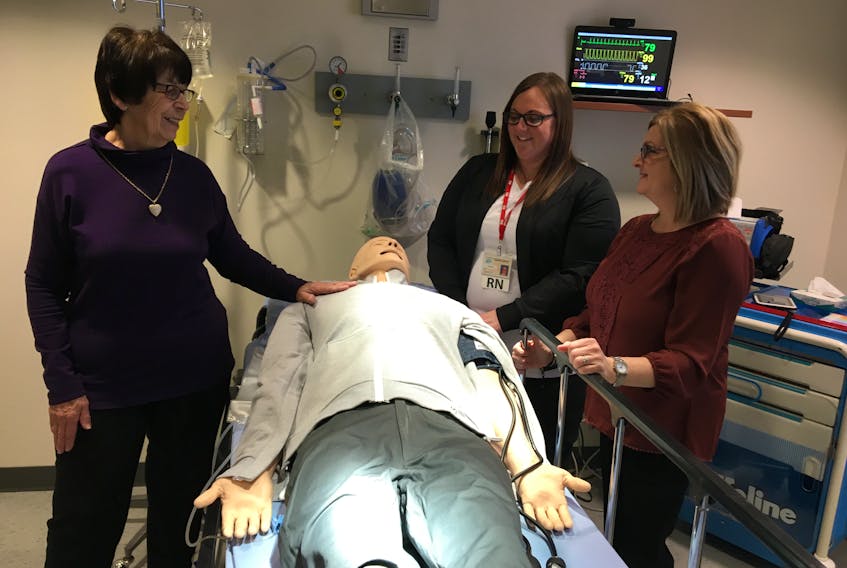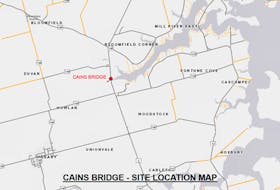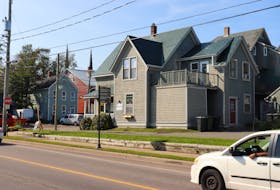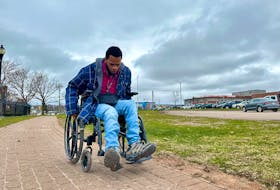O'LEARY, P.E.I. — Members of the O’Leary Community Health Foundation watched in awe as Stephanie Gaudet ran a variety of tests on a medical mannequin, Sim Man ALS (Advanced Life Support), in Community Hospital’s new training lab.
The recent demonstration by the Clinical Nurse Educator for Community Hospitals West was a proud moment for hospital staff and the foundation. It was roughly a year ago that staff approached the foundation about the need for a simulator training lab.
Once foundation members were able to visualize how the lab would function then they were all onboard, recalls the hospital’s Director of Nursing, Susanne LaPierre.
LaPierre and Cheri Harris, clinical leader for the in-patient unit, toured simulator labs at Prince County Hospital, Queen Elizabeth Hospital, Queen Elizabeth II Health Centre and UPEI for ideas and chose elements that they felt would work best in O’Leary.
They have male and female (Nursing Annie) mannequins and a chest (Chester) on which medical simulations can be set up and manipulated via tablet. Vitals are displayed on a wall-mounted monitor.
“I believe it is the first rural facility in Canada to have its own simulator lab,” Community Hospitals West administrator Paul Young said.
The cost of the simulators was just under $60,000. The Hospital Auxiliary covered $5,000 of the cost and the foundation covered the rest.
“It’s quite incredible the amount that’s been done just with the repurposing of existing resources."
- Paul Young
Young said converting a former TV quiet room for in-patients into a simulator lab, an adjacent washroom into an observation room and a room across the hall into simulator lab storage area cost less than $1,000. The examination room lights in the ceiling would ordinarily cost $20,000, but they were repurposed from an in-patient room which once served as a labour and delivery room.
Gaudet said she had been storing up expired IV tubing and equipment for use in the lab.
“It’s quite incredible the amount that’s been done just with the repurposing of existing resources,” Young said.
But staff said the room would not have been possible without the ongoing support of the hospital foundation.
'Hands-on training'
Foundation member Eileen Brown said she is impressed with how the lab turned out and with the promise it holds.
Gaudet said hospital staff can use the lab to build competence and confidence in a risk-free environment.
“It allows them to come in, gives them that repetitive hands-on training.”
LaPierre expects staff from both Western and Community Hospitals will use the simulation lab when working on certification and re-certification in advanced care life support.
The lab only opened last month and, already, paramedics with Island EMS have used it to practice scenarios. Firefighters and other emergency workers can also schedule time in the lab. Harris or Gaudet will need to be in attendance to help run the simulations.
A new classroom also opened in the hospital last month and staff expects to be able to use it in tandem with the simulation lab. Community groups can also use the classroom for training, Young said.
The simulation lab is set up at the end of the in-patient wing, thus allowing those attending sessions to arrive through the cafeteria entrance so as not to disrupt the in-patient unit.
Young suggests the lab will also be an important resource for recruiting physicians. He noted Dr. Maloney, who is expected to arrive from South Africa by late spring, was particularly impressed about having access to such a resource in a rural setting.









